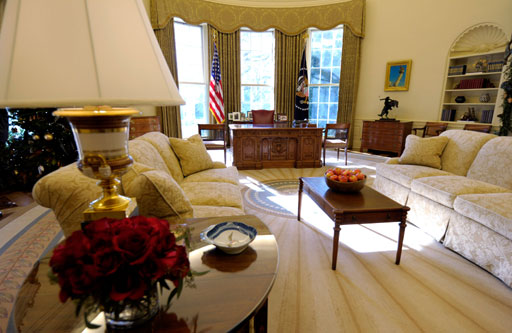|
 President Barack Obama's Oval Office is seen at the White House in Washington, Tuesday, Dec. 29, 2009.(Agencies)
|
Click for more photos of Oval Office
|
The decorative china plates are long gone. Historic metal gadgets and Native American pottery now stand in their stead. Resting on a bookshelf is a framed program from the 1963 March on Washington, where civil rights leader Martin Luther King Jr. delivered his famous "I have a dream" speech. President Barack Obama gradually has made the Oval Office his own. To varying degrees, each president puts his own imprint on this celebrated workspace. Even the smallest change - Obama's penholder, for example - is closely watched for symbolism. While recent presidents have each done a big overhaul upon taking office, Obama decided against major redecorating. It would have struck a sour note in a time of economic distress. But over his first year in the White House, the office has come to reflect his tastes. The table behind Obama's desk is full of family photos - a wedding picture, shots of his girls as toddlers, a picture from the day he announced for president and more - photos that he says remind him "why I'm doing what I'm doing." Out the window, the president can watch daughters Sasha and Malia climb on the playscape erected for them last spring. There's now a bust of King in the Oval Office, in addition to the March on Washington program that previously hung on Obama's "wall of heroes" in his Senate office. "This office, I think, reminds you of what's at stake, how many hopes and dreams are placed in what goes on here at the White House," Obama said in a recent television interview with talk show host Oprah Winfrey. Perhaps no room in the White House is more closely associated with the presidency. It is where Obama signs letters to the families of fallen soldiers. Where he told his war council of his decision to ship thousands more troops to Afghanistan. Where he receives daily briefings on the security threats facing the nation and on the state of the economy. As Obama on updating the look of the Oval Office, in came four pieces of pottery by contemporary Native American artists, all on loan from the National Museum of the American Indian. Also new to the Obama bookshelves are three mechanical devices on loan from the National Museum of American History's patent collection: models for Samuel Morse's 1849 telegraph register, John Peer's 1874 gear-cutting machine and Henry Williams' 1877 feathering paddlewheel for steamboats. White House curator William Allman said the patent models fit Obama's personality - his "interest in American history, his interest in technology and his interest in the creative spirit." (Read by Lee Hannon. Lee Hannon is a multimedia journalist at the China Daily Web site.) 點擊查看更多雙語新聞
|
瓷盤裝飾品早就不見蹤影,取而代之的是具有歷史紀念意義的金屬器件和印第安陶器。書架上擺放著1963年“華盛頓游行”活動計劃的相框,就在這次活動中,民權(quán)運動領(lǐng)袖馬丁?路德?金發(fā)表了著名的演講《我有一個夢想》。 這是白宮橢圓形辦公室目前的內(nèi)部擺設(shè),美國總統(tǒng)貝拉克?奧巴馬逐漸將其改造成了自己的風格。 美國歷任總統(tǒng)在這個著名辦公地點都不同程度地留下了自己的印記。甚至是奧巴馬的筆筒這種最不起眼的變化,都被視為某種象征而受到密切關(guān)注。 盡管最近幾任總統(tǒng)在就職后都對辦公室進行了大規(guī)模改造,但奧巴馬則不打算這樣做。在經(jīng)濟困難時期,這樣做可能會招致不滿,但奧巴馬入主白宮一年以來,橢圓辦公室越來越具有他的風格。 奧巴馬辦公桌后面的桌子上擺滿了家庭照片,包括他與米歇爾的結(jié)婚照、兩個女兒年幼時的照片以及宣誓就職的照片等等。奧巴馬稱這些照片提醒他“為什么要做現(xiàn)在正在做的事情”。透過窗戶,奧巴馬可以看到女兒薩莎和瑪麗亞在去年春天為她們搭建的游樂器械上玩耍。 除了“華盛頓游行”的活動計劃外,橢圓形辦公室里還擺放了馬丁?路德?金的半身像。“華盛頓游行”計劃相框之前掛在奧巴馬參議院辦公室的“英雄墻”上。 近日,奧巴馬在接受脫口秀電視節(jié)目主持人奧普拉?溫芙瑞的采訪時說:“我覺得這個辦公室可以提醒你什么是利害攸關(guān)的,有多少希望和夢想被寄托在這里。” 也許橢圓辦公室是白宮最具“總統(tǒng)味”的地方。 在這里,奧巴馬簽署發(fā)給陣亡士兵家屬的信件,向戰(zhàn)爭委員會宣布向阿富汗增兵數(shù)萬的決定,參閱安全威脅和經(jīng)濟狀況每日簡報。 當奧巴馬重新打造自己的橢圓辦公室時,由當代印第安藝術(shù)家打造的四件陶器進駐白宮,這些工藝品均借自美國印第安人國家博物館。此外,書架上還增添了從美國歷史博物館借來的三件機械專利藏品,分別是1849年薩繆爾?摩爾斯發(fā)明的電報機模型,1874年約翰?皮爾發(fā)明的齒輪加工機床模型,以及1877年亨利?威廉姆斯發(fā)明的汽船活葉明輪模型。 白宮館長威廉?埃爾曼稱,這些專利模型很符合奧巴馬的個性,符合他“對美國歷史、科技和創(chuàng)新精神的興趣”。 相關(guān)閱讀 (中國日報網(wǎng)英語點津 Julie 編輯蔡姍姍) |
|
Vocabulary: strike a sour note:to signify something unpleasant(使情緒不好,引起反感) shot:a photograph(照片) toddler:a young child learning to walk(初學走路的孩子) bust:a sculpture representing a person's head, shoulders, and upper chest(半身像) |
